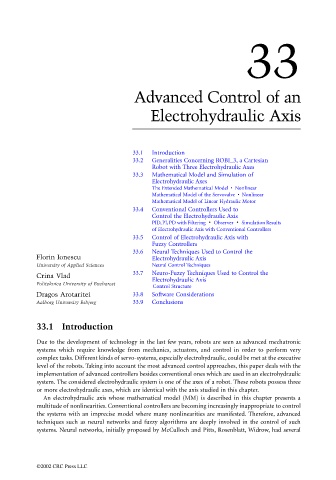Page 977 - The Mechatronics Handbook
P. 977
33
Advanced Control of an
Electrohydraulic Axis
33.1 Introduction
33.2 Generalities Concerning ROBI_3, a Cartesian
Robot with Three Electrohydraulic Axes
33.3 Mathematical Model and Simulation of
Electrohydraulic Axes
The Extended Mathematical Model • Nonlinear
Mathematical Model of the Servovalve • Nonlinear
Mathematical Model of Linear Hydraulic Motor
33.4 Conventional Controllers Used to
Control the Electrohydraulic Axis
PID, PI, PD with Filtering • Observer • Simulation Results
of Electrohydraulic Axis with Conventional Controllers
33.5 Control of Electrohydraulic Axis with
Fuzzy Controllers
33.6 Neural Techniques Used to Control the
Florin Ionescu Electrohydraulic Axis
University of Applied Sciences Neural Control Techniques
Crina Vlad 33.7 Neuro-Fuzzy Techniques Used to Control the
Electrohydraulic Axis
Politeknica University of Bucharest
Control Structure
Dragos Arotaritei 33.8 Software Considerations
Aalborg University Esbjerg 33.9 Conclusions
33.1 Introduction
Due to the development of technology in the last few years, robots are seen as advanced mechatronic
systems which require knowledge from mechanics, actuators, and control in order to perform very
complex tasks. Different kinds of servo-systems, especially electrohydraulic, could be met at the executive
level of the robots. Taking into account the most advanced control approaches, this paper deals with the
implementation of advanced controllers besides conventional ones which are used in an electrohydraulic
system. The considered electrohydraulic system is one of the axes of a robot. These robots possess three
or more electrohydraulic axes, which are identical with the axis studied in this chapter.
An electrohydraulic axis whose mathematical model (MM) is described in this chapter presents a
multitude of nonlinearities. Conventional controllers are becoming increasingly inappropriate to control
the systems with an imprecise model where many nonlinearities are manifested. Therefore, advanced
techniques such as neural networks and fuzzy algorithms are deeply involved in the control of such
systems. Neural networks, initially proposed by McCulloch and Pitts, Rosenblatt, Widrow, had several
©2002 CRC Press LLC

